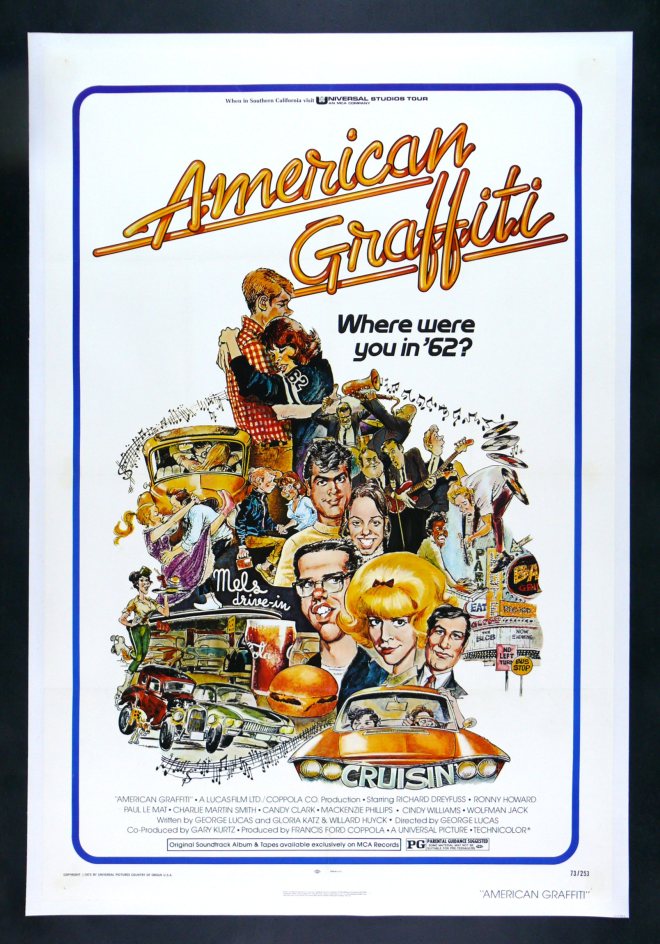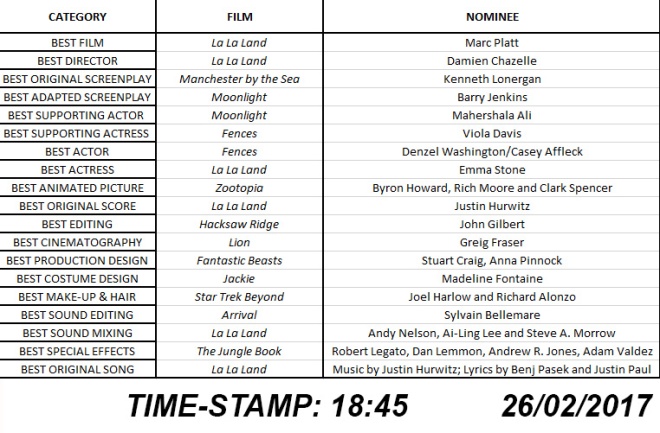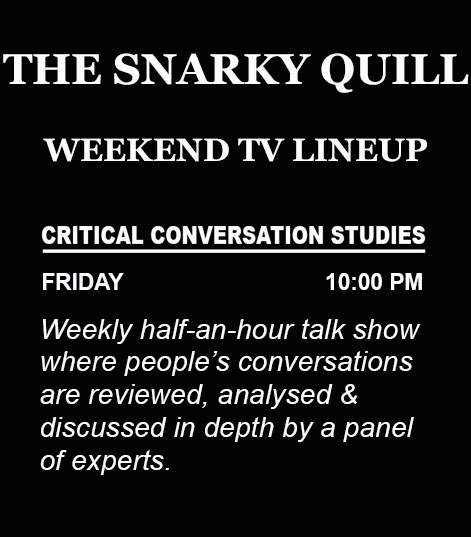RATING

American Graffiti is a ‘first’ of many: George Lucas’ first commercial success, Harrison Ford’s first collaboration with Lucas, and the first film where the soundtrack used an array of songs as a cinematic device, widely imitated today from auteurs like Paul Thomas Anderson and Quentin Tarantino to tentpole fare like Guardians of the Galaxy. George Lucas was truly ahead of his time, rewriting the rules before he’d rewrite the rules yet again in 1977.
In hindsight, American Graffiti is often seen as a precursor to Lucas’ oeuvre after he went on to make a certain space opera called Star Wars but that would be a pity. American Graffiti is a wonderful film, a time capsule affording us a glimpse of a time and place Lucas grew up that feels both alien and utterly contemporary, yet no longer exists today. It’s an apt highlight of the creative sensibilities that Lucas could be capable of delivering if he wasn’t busy chasing the merchandise.
Time: 1962. Scene: Modesto, California. A group of graduating students have a series of separate adventures over the course of a single night. Player 1: Curt Henderson (Richard Dreyfuss). He’s won a scholarship to a university but is reluctant to leave. Player 2: Steve (Ron Howard, credited here as “Ronny Howard”). He’s the straight A-student so eager to leave that he suggests to girlfriend and Curt’s sister, Laurie (Cindy Williams) that they see other people. Player 3: Terry ‘the Toad’ Fields (Charles Martin Smith). Modesto’s residential nerd behind thick-rimmed glasses given the keys to Steve’s prized car to look after while he’s gone. Player 4: John Milner (Paul Le Mat). The fastest racer in the valley with the looks and fashion sense of James Dean and Marlon Brando, down to the white vest with short rolled-up sleeves and nonchalant attitude. He may have peaked in his adolescence and is resorted to upholding his only achievement as a racer. Ironic that despite owning a car, he’s stuck in Modesto.
Curt wanders around town in search of a mystery blonde woman (Suzanne Somers) driving a T-bird, and winds up in the clutches of Modesto’s gang, the Pharaohs. Steve and Laurie try to enjoy their last night but ends up getting into the vehicle of Bob Falfa (Harrison Ford), who’s searching to race John, who tries to pick a carload of beautiful women and ends up spending the night driving the twelve-year-old Carol (Mackenzie Philips) around town instead.
Toad, meanwhile, succeeds in picking up a beautiful blonde bombshell, Debbie (Candy Clark), thanks to Steve’s car, and spends the whole night trying to impress by making himself appear ‘cool’, whatever that means. Intertwined throughout is the broadcast of mysterious and legendary radio Disc Jockey Wolfman Jack, playing himself, serving as the film’s spine as the four stories weaved in and out of different songs throughout.
All these characters, except Steve’s, resemble different facets of George Lucas. Terry was Lucas in high school, shy around girls. Milner was the Lucas who spent his days cruising the strip. And Curt was the Lucas in his days at the University of Southern California. Writing may have been hell on Lucas but the man had ideas.
American Graffiti did not come into this world easy. It had to fight for breath and struggle from conception. Francis Ford Coppola’s Zoetrope studio had gone bust and had taken on “The Godfather” to pay some debts. His protégé, George Lucas, was struggling after his debut film, THX 1138, failed to make much money. Coppola and editor-first wife, Marcia Lucas, convinced Lucas to write something closer to his own life, less abstract and more “human”.
Lucas would hire producer Gary Kurtz to assist him, a collaboration that would continue on to Star Wars. Combining his love for fast cars and fascination for the role they played in teenagers’ dating lives, Lucas put together a script with writers Gloria Kutz and Willard Huyck. Swallowing his pride, he approached the Hollywood studios for money. Only Ned Tanen at Universal would bite, having already been a fan of Lucas’s early student films. At least Tanen seemed to have an inkling what Lucas was attempting to achieve with his “musical”.
And what a musical it was! Instead of being a film in the traditional musical vein, American Graffiti featured zero singing and the only dance sequences were those in the school sock hop. Instead of original music, Lucas licensed the work of Buddy Holly, the Beach Boys, Fats Domino, and Chuck Berry to create an auditory skin that was integral to the fabric of the film’s aesthetics. Such a move is commonplace in the present day but back then, it was a bold and daring movie. With the help of the legendary cinematographer Haskell Wexell, American Graffiti would end up looking and sounding like a cinematic jukebox, what with its bright lights and Techniscope cinematography.
The shoot was a gruel. Setting up took hours, the cars tended to break down and the local council of San Rafael withdrew the filming permit. These constraints, and the fact that they were behind schedule, would from day one, only served to enforce American Graffiti’s documentary aesthetic as they moved quick and rapidly. By the end of this ordeal, Lucas would succumb to flu. None of it would be in vain: Lucas’ on-the-fly approach resulted in providential cinematic magic when American Graffiti opened with Toad cruising up to Mel’s Drive-In on his moped and crashing into the vending machines. It was an unplanned accident that started off the film on the right foot.
What is it about American Graffiti that still resonates today? Perhaps it’s the nostalgia for a time that can never be brought back. American Graffiti was a snapshot of a world and time before the Kennedy assassination, a turning point in American pop culture vernacular just as 9/11 would similarly do in 2001. There’s a sweetness and earnestness to the proceedings and the characters are treated with human tenderness, even the members of the Pharaoh gang who are impressed enough by Curt to induct him into their fold.
Yes, the trappings, the vehicles and even the music come from a different time. Yet anyone can empathise with Toad’s clumsy attempts to woo a beautiful girl by pretending to be somebody they’re not for fear of not being liked. Couples today have Skype and the Internet to keep in constant communication over continents, yet anyone who has been in a long-distance relationship can relate to Steve’s and Laurie’s predicament. Students who excelled in school but struggle in the real world share John Milner’s fears that his glory days are already behind him. And in an era where there is pressure to ‘see the world’ and travel, who hasn’t felt Curt’s anxieties at least once?
If American Graffiti had a hard time getting a studio release back then, it wouldn’t stand a chance today. In an ironic twist of fate, Lucas’s ushering of the blockbuster trend rendered the cinematic landscape hostile to these kinds of movies. The only way a story like this could score a greenlight would be as an American Graffiti reboot. Only: the cast would look too old and too supermodel-handsome to be convincing teenagers, Curt might find the T-bird bombshell through Instagram and everyone might keep track of each other through their check-ins on Facebook, Twitter updates or texts through Whatsapp. Ah, how fast the dating rituals change!
~
DIRECTED BY: George Lucas
PRODUCED BY: Francis Ford Coppola
SCREENPLAY BY: Gloria Katz, Willard Huyck, George Lucas
EDITED BY: Verna Fields and Marcia Lucas
CINEMATOGRAPHY: Ron Eveslage, Jan D’Alquen
VISUAL CONSULTANT: Haskell Wexler
STARRING: Richard Dreyfuss, Ron Howard, Paul Le Mat, Charles Martin Smith, Candy Clark, Mackenzie Phillips, Cindy Williams, Wolfman Jack
~


